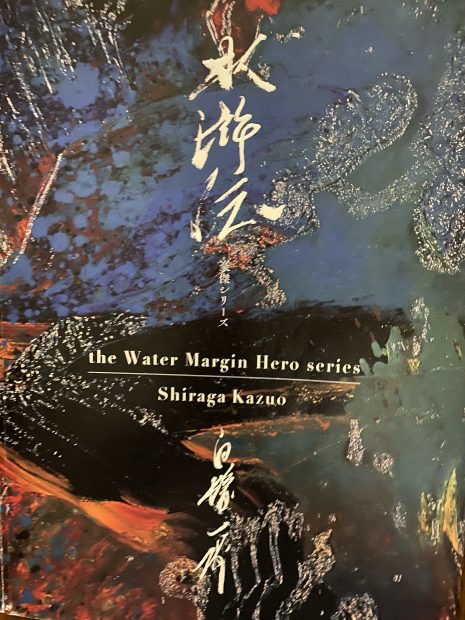白髪一雄<水滸伝> Kazuo Shiraga “The Water Margin Hero Series”

白髪一雄と水滸伝
白髪一雄と水滸伝
<水滸伝シリーズ>アップの切掛は晩年の白髪さんが水滸伝シリーズの作品データー作りに執念しておられたお姿です。私も情報提供で協力させていただき
白髪さんの没後も水滸伝の作品データーを作成しつづけました。
それは決して一堂に会することのない 108 点の豪傑・作品を集めることへの夢を孵卵していたからです。
インスタグラムを弄んでいましてふと、このツールなら水滸伝シリーズの作品を一堂に集められるのでは?と思いついたのです。
しかし、インスタグラム自体が不安定なツールであること、又長文には適さないこともあり不備な点の修正もかねてブログにアップすることにしました。
さて<水滸伝>を幼少期から熟読していた白髪さんにとっては人間形成の血肉となっていたと思います。 108 人の好漢いな無頼漢は今の子供達の怪獣のように白髪さんの内で鮮明に存在していたことでしょう。
<水滸伝シリーズ>の作品名は〜直感的に付けたんやから拘らないで〜と白髪さんはいってますが、この度一点一点照合してみて決してあてずっぽうでないことに気付きました。 タイトルのヒーローのイメージは作品と重なるのです。
造形の純粋性を追求する師・吉原治良の〜作品に名前をつけるな〜は面従腹背、いったんキャンバスに上がれば(普通は向かえばですが)無頼漢達が白髪さんに乗り移ってくるのです。
106点の作品は最も脂の乗り切った30代に集中的に制作されています。なんと 41 点は35才に描かれているのです。
しかし、2点を残して完結するのに 40 余年の時間がかかりました。
〜わしはどない悪人でもええがこそ泥は嫌いなんや、あいつらはなかなか描く気がせえへんかったんや〜
地賊星鼓上蚤はアート・遊で題名を入れられたという縁がある作品です。
〜これでやっと完結した〜感無量なお顔が今も鮮明に浮かんできます。ライフワークとしての<水滸伝>への執念を強く受けました。
ちなみに気の乗らなかった地賊星鼓上蚤は、たまたま取り寄せた古本屋の北斎の挿絵のあまりにもの格好よさに触発されて描かれたのです。その勢いで地耕星白日鼠も描き<水滸伝>は完結したのです。
もう一つの私の長年の謎は上方のええしのぼんぼんである白髪さんとあまりにも凄すぎる作品のとのギャップです。柔らかな上方の言葉と温厚な一市井人としたお人柄との落差です。
「泥にいどむ」や師の吉原さんをギョッとさせた牛の内臓の「赤い液」、切り裂かれた「猪狩」、闘いの痕跡のような血痕を思わすクレムソンレーキの平面の作品などもう猟奇的な世界です。
この発想はどこからくるのか、温厚な大人(たいじん)白髪さんのどこから生まれてくるのか不思議でなりませんでした。
その源泉は<水滸伝>なのだ!と、私は思います。
解き放された 108 の星はあらゆる階級に産まれて、義侠心のためなら残虐残忍の限りを尽くす、人を殺して肉団子にするとか、内臓を取り出して酒漬けににするとかもう猟奇の世界です。
日本的な精神構造の許容範囲を超える世界です。
幼少からこの世界に馴染んでいたのです。
具体協会も決して平穏ではありませんでした。何度もトラブルがありメンバーは次々と脱会していきました。しかし白髪さんは最後までびくともされなかったのです。決して世間知らずのぼんぼんではありません。清濁合わせ飲む度量の大きな器の持ち主なのです。飲むといえば大酒豪でした。これは正に大酒飲みの豪傑達の影響です。
白髪一雄の画業を見るとき<水滸伝>は抜き差しならないものであることを改めて確認しました。
余談;晩年の白髪さんは膝痛に悩まされておられました。あるとき〜これなんやと思う?〜と折り畳みの杖を机に、〜東京の画廊がアクションペインテングが杖ついてきてもろたら困るといわれるんや〜私も膝痛がわかる年になりました。
(著作権の認証とか美術館への承認済)
(著作権の認証とか美術館への承認済)
Kazuo Shiraga<SUIKODEN>
I post the <Suikodn series >on Instagram because Mr. Shiraiga, an old man, had a hard time creating data for the <Suikodn series >.
I also cooperated in providing information. Even after the death of Mr. Shiraga, I continued to create data for Suikoden's works.
It was because I had a long dream of collecting 108 works that could never be collected.
While playing around with Instagram, I wonder if this tool could bring together all the Suikoden series of works. I came up with.
However, since Instagram itself is an unstable tool and it is not suitable for long sentences, I decided to post it on the blog because I could not fix any deficiencies.
<SUIKODEN> could have been the human-formed flesh and blood of the gray hair that had completely read all publications and Chinese versions of the original language since childhood.
The feelings of childhood are clearly input throughout life. The 108 heroes would have survived as clearly as the monster characters of today's children, with their Shiraga.
When you start making it on canvas, the monster turns gray. The word “don't name the work”, which seeks for the pureness of the master's Jiro Yoshihara, disappears from Shiraga.
If you look at the works, it seems that way. Isn't it a trace of a bloody battle? There is a word that intuitively names Mr. Shiraga, but it is natural. There are some great guys in the Shiraga.
The 106 productions are concentrated in their most powerful thirties. I'm producing 41 works at the age of 35.
However, it took more than 40 years to complete with only two points left.
~ I like big villains, but I hate mud, so the other two didn't feel like drawing ~
- Chosei's work happened to be bought at a used bookstore
The illustration of Hokusai's book was so cool that I was inspired to draw it. With the momentum, 106 Geostars were also drawn.
Chizokusei is a work that has a connection with having a title in Art-Ugallery.
~It's finally complete~ I can still clearly see the infinite amount of faces. That feeling will not be realized by others.
Another mystery over the years is the gap between Shiraga, the son of the upper class, and his intense work. It is the difference between good words and a gentle personality.
The "red mud" of the internal organs of the cow that made Mr. Yoshihara scared, "the boar hunted", the Clemson Rake's plane work that reminds me of blood marks like the struggle of battle, etc. It is an abnormal world.
I was wondering where this idea came from, and where the gentle adult gray hair came from.
The origin is < SUIKODEN>! I think.
Unleashed 108 stars are born and transformed in every class. They are a terrible, terrible story world where they do their best to be brutally brutal, kill people to make meat dumplings, or take out their internal organs and make them pickled.
It is a world that exceeds the permissible range of Japanese mental structure.
The concrete association was never peaceful either. There were many troubles and the members left the group one after another. However, Shiraga was not upset until the end. Nor is it a pure person. He has a big heart to swallow both good and bad things. Shiraga was a drunkard when it came to drinking. This is exactly the influence of the members of <SUIKODEN> who are drunkards.
When I saw Kazuo Shiraga's art, I once again confirmed that <Suikoden> is something that cannot be removed.
P.S
The second half of my gray hair was knee pain. What do you think this is at one point? I put a folding cane on the table.
~ When I was told at an art gallery in Tokyo that action painters would have a cane,
It is now a year when I can feel the pain in my knees.
